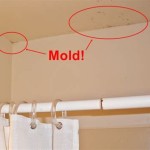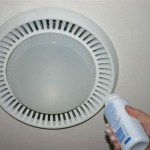How to Paint a Mould-Infested Bathroom Ceiling Fan
Mould growth is a common problem in bathrooms due to the high humidity and inadequate ventilation. Bathroom ceiling fans, designed to mitigate these conditions, can themselves become breeding grounds for mould and mildew. Painting a mould-infested bathroom ceiling fan is a necessary maintenance task that addresses both aesthetic issues and potential health concerns. This article outlines a comprehensive guide to safely and effectively painting a mould-infested bathroom ceiling fan.
Safety is paramount when dealing with mould. The process requires careful preparation, proper execution, and appropriate safety measures to prevent the spread of mould spores and protect the health of the individual undertaking the task. Failing to address the mould issue properly can lead to recurring growth and potential structural damage over time.
Preparation: Ensuring a Safe and Effective Environment
The initial phase involves meticulous preparation, focused on both safety and creating an optimal environment for the painting process. This includes gathering the necessary tools and materials, preparing the fan and the surrounding area, and implementing essential safety precautions.
Required Materials and Tools:
*Mould-Killing Cleaner: A specifically formulated mould-killing cleaner is essential for effectively eliminating existing mould and preventing regrowth. Ensure the cleaner is suitable for use on the materials of the fan (typically plastic or metal).
*Cleaning Supplies: This includes scrub brushes (a soft-bristled brush for general cleaning and a stiffer brush for stubborn mould), sponges, cloths, and paper towels for cleaning and wiping surfaces.
*Safety Gear: Essential safety gear includes a respirator or N95 mask to prevent inhalation of mould spores and paint fumes, safety glasses to protect the eyes, and gloves to prevent skin contact with mould and cleaning solutions.
*Primer: A mould-resistant primer is crucial for creating a barrier against future mould growth and ensuring proper adhesion of the paint. Choose a primer specifically designed for use in humid environments.
*Paint: Select a high-quality, moisture-resistant paint specifically formulated for bathrooms. Semi-gloss or gloss finishes are recommended as they are more resistant to moisture and easier to clean. Consider an anti-mould paint for enhanced protection.
*Paint Supplies: This includes paint brushes (various sizes for different areas of the fan), paint rollers (for larger, flat surfaces), paint trays, and painter's tape to protect surrounding surfaces.
*Screwdrivers: A variety of screwdrivers (Phillips head and flathead) may be needed to disassemble the fan for cleaning and painting.
*Drop Cloths: Protect the bathroom floor and other surfaces with drop cloths to prevent paint splatters and drips.
*Ladder or Step Stool: A stable ladder or step stool is necessary to safely reach the ceiling fan.
Preparing the Area:
*Power Off: Before starting any work on the ceiling fan, turn off the power to the fan at the circuit breaker to prevent electrical shock.
*Disassembly: Carefully disassemble the fan, removing the blades, light fixture (if applicable), and any other removable components. Take photographs or make notes of the assembly process to aid in reassembly. Place all removed parts on a protected surface (e.g., covered with a drop cloth).
*Protection: Cover the surrounding area with drop cloths to protect the floor, walls, and any other fixtures from paint and cleaning solutions. Use painter's tape to mask off any areas that you don't want to paint, such as the edge of the ceiling around the fan mounting.
*Ventilation: Ensure adequate ventilation in the bathroom by opening windows and doors, if possible. Use a fan to circulate the air and remove fumes.
Safety Precautions:
*Personal Protective Equipment: Always wear a respirator or N95 mask, safety glasses, and gloves throughout the entire process, from cleaning to painting.
*Avoid Direct Contact: Minimize direct contact with mould spores. Wash hands thoroughly with soap and water after handling the fan and any cleaning solutions.
*Proper Disposal: Dispose of contaminated cleaning supplies (e.g., sponges, cloths, paper towels) in a sealed plastic bag to prevent the spread of mould spores. Check local regulations for proper disposal methods.
Cleaning and Removing Mould: Eliminating the Source
Once the area is prepared and safety measures are in place, the next step involves thoroughly cleaning the fan components and removing all traces of mould. This is a critical step to ensure successful painting and prevent future mould growth.
Cleaning the Fan Components:
*Dry Cleaning: Before applying any cleaning solution, use a brush or vacuum cleaner with a brush attachment to remove loose dust and debris from the fan blades, housing, and other components. This will prevent the cleaning solution from becoming contaminated with dust.
*Applying Mould-Killing Cleaner: Apply the mould-killing cleaner to all surfaces of the fan components, following the manufacturer's instructions. Ensure that all areas affected by mould are thoroughly saturated with the cleaner. Allow the cleaner to dwell on the surfaces for the recommended time (typically 10-15 minutes) to kill the mould spores effectively.
*Scrubbing: Using a scrub brush (soft-bristled for general cleaning, stiffer for stubborn mould), scrub all surfaces of the fan components to remove mould and mildew. Pay particular attention to areas with heavy mould growth. For hard-to-reach areas, use a smaller brush or cotton swabs.
*Rinsing: After scrubbing, rinse all fan components thoroughly with clean water to remove any remaining cleaning solution and dislodged mould. Ensure that all traces of the cleaner are removed, as residue can interfere with paint adhesion.
*Drying: Allow all fan components to dry completely before proceeding to the next step. Use a clean cloth or paper towels to wipe away excess water. You can also use a fan or dehumidifier to accelerate the drying process. Ensure that the components are completely dry, as moisture can lead to mould regrowth under the paint.
Addressing Stubborn Mould:
*Repeat Cleaning: If mould persists after the initial cleaning, repeat the cleaning process with the mould-killing cleaner. You may need to apply the cleaner multiple times and scrub more aggressively to remove stubborn mould.
*Bleach Solution (Use with Caution): If mould is extremely resistant to the mould-killing cleaner, a diluted bleach solution (1 part bleach to 10 parts water) can be used as a last resort. However, bleach can damage certain materials (e.g., metal) and can release harmful fumes, so use it with extreme caution. Always wear appropriate safety gear (respirator, safety glasses, gloves) and ensure adequate ventilation. Apply the bleach solution to the affected areas, let it dwell for a few minutes, and then scrub thoroughly. Rinse thoroughly with clean water and allow to dry completely.
*Sanding (If Applicable): If the mould has deeply penetrated the surface of the fan components, light sanding may be necessary to remove the affected areas. Use fine-grit sandpaper and sand gently to avoid damaging the surface. After sanding, clean the area thoroughly to remove sanding dust.
Inspection:
*Thorough Inspection: After cleaning and drying, carefully inspect all fan components to ensure that all traces of mould have been removed. Look for any remaining discolouration or signs of mould growth. If any mould remains, repeat the cleaning process.
*Addressing Underlying Issues: Identify and address the underlying cause of the mould growth. This may involve improving ventilation in the bathroom, repairing leaks, or reducing humidity levels.
Painting: Applying Primer and Paint for Protection and Aesthetics
Once the fan components are thoroughly cleaned and dried, the final step is to apply primer and paint. This will provide a protective barrier against future mould growth and improve the appearance of the fan.
Priming:
*Applying Primer: Apply a thin, even coat of mould-resistant primer to all surfaces of the fan components. Use a paint brush or roller, depending on the size and shape of the components. Follow the manufacturer's instructions for application and drying time. Ensure that all areas are thoroughly covered with primer, especially those that were previously affected by mould.
*Drying Time: Allow the primer to dry completely before proceeding to the next step. The drying time will vary depending on the type of primer and the environmental conditions. Refer to the manufacturer's instructions for the recommended drying time.
*Sanding (Optional): If the primer creates a rough surface, lightly sand it with fine-grit sandpaper to create a smooth surface for the paint. Clean the surface thoroughly after sanding to remove sanding dust.
Painting:
*Applying Paint: Apply a thin, even coat of moisture-resistant paint to all surfaces of the fan components. Use a paint brush or roller, depending on the size and shape of the components. Follow the manufacturer's instructions for application and drying time. For best results, apply two coats of paint, allowing each coat to dry completely before applying the next.
*Brush Strokes: Use smooth, even brush strokes or roller strokes to avoid streaks or uneven coverage. Overlap each stroke slightly to ensure complete coverage.
*Drying Time: Allow each coat of paint to dry completely before applying the next. The drying time will vary depending on the type of paint and the environmental conditions. Refer to the manufacturer's instructions for the recommended drying time.
*Touch-Ups: After the final coat of paint has dried, inspect the fan components for any imperfections or areas that need touch-ups. Apply additional paint as needed to achieve a uniform finish.
Reassembly:
*Reassembling the Fan: Once the paint is completely dry, carefully reassemble the fan, following the photographs or notes that were taken during disassembly. Ensure that all components are properly aligned and securely fastened.
*Testing: After reassembling the fan, turn the power back on at the circuit breaker and test the fan to ensure that it is functioning properly. Check the fan blades for balance and adjust as needed.
By following these steps, it is possible to effectively clean, prime, and paint a mould-infested bathroom ceiling fan, improving its appearance and preventing future mould growth. Regular cleaning and maintenance will help to keep your bathroom ceiling fan functioning properly and prevent the recurrence of mould problems.

Cleaning Mrs Hinch Fans Share Tips To Remove Ceiling Mould Express Co

What Is The Best Way To Remove Mold From Bathroom Ceiling

Bathroom Mold How To Identify And Get Rid Of In Environix

Bathroom Ceiling Mold Removal When To Clean Call Branch Environmental

Ceiling Mold Growth Learn The Cause And How To Prevent It Environix

How To Clean Bathroom Ceiling Fans Simple Method

Black Mould Removal The Right Way

Home Dzine Bathrooms Quick Tip Get Rid Of Ceiling Mould

How To Prevent Mould On The Bathroom Ceiling Dbs Bathrooms

How To Get Rid Of Mold On Your Bathroom Ceiling Aqa
Related Posts







